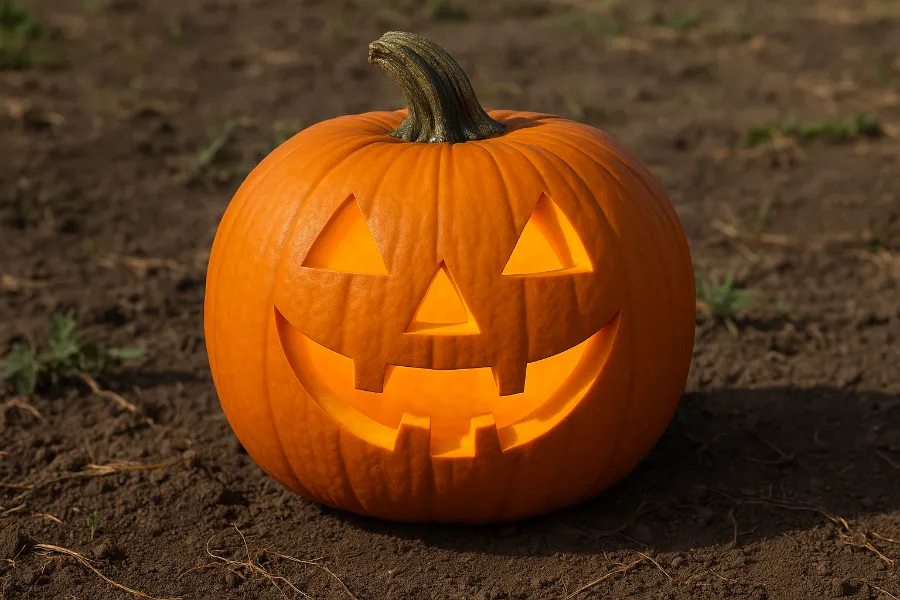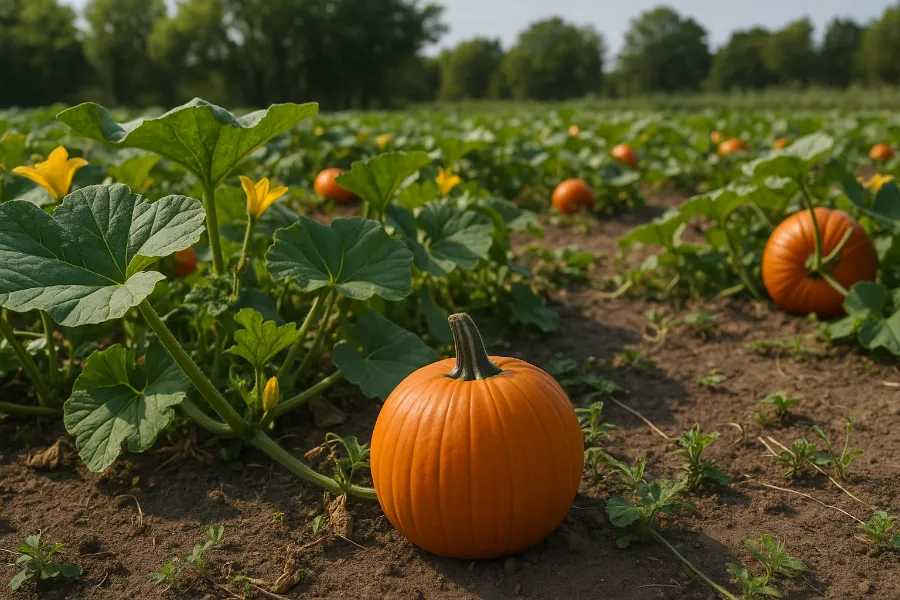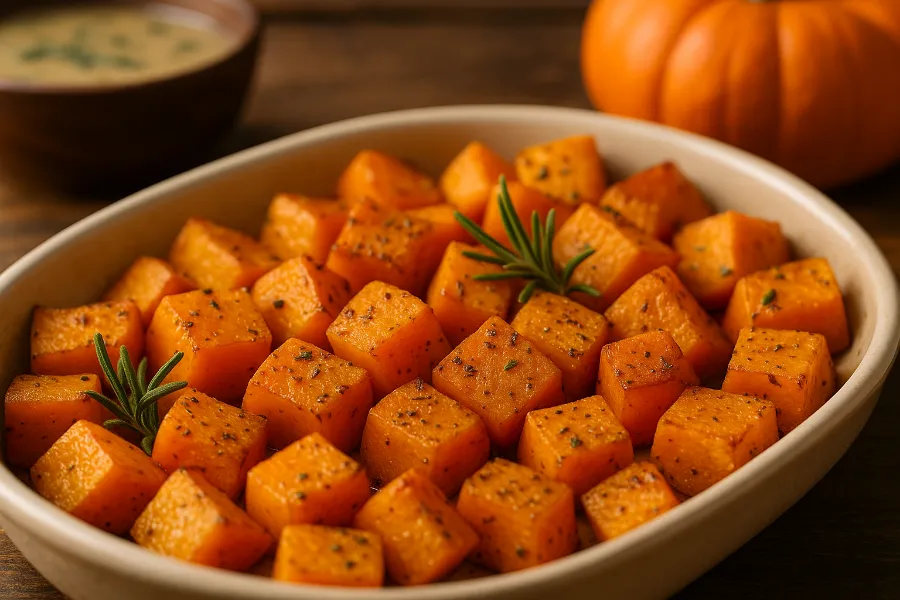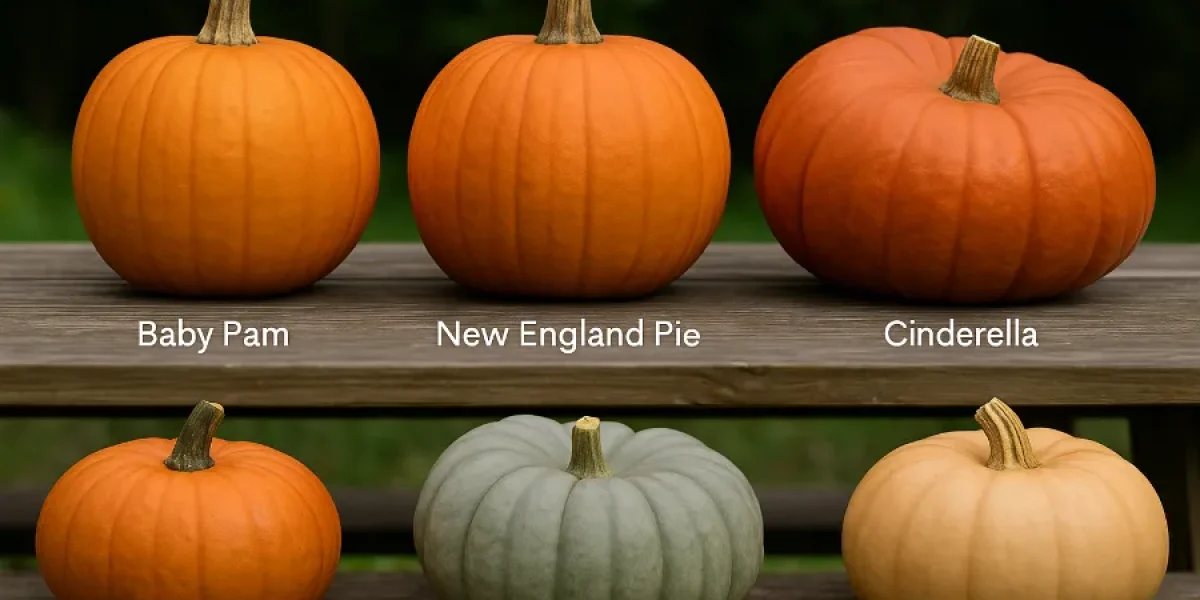Every autumn, I find myself standing in front of a mountain of pumpkins—big, small, smooth, bumpy—trying to decide which ones are just for show and which ones will actually make something delicious. And let me tell you, there’s a world of difference between the two.
The real contest is sugar pumpkin vs carving pumpkin. One is grown for flavor, the other for fun. Yet many shoppers toss them into the same basket, not realizing that one of them will give you the creamiest pumpkin pie filling you’ve ever tasted, and the other might leave you disappointed with watery puree and weak flavor. So, let’s take a walk through the pumpkin patch together—comparing flavor, texture, size, and even how these pumpkins grow—so you’ll know exactly which one belongs in your kitchen this fall.
Carving Pumpkin: Big, Bold, and Made for Halloween

There’s something special about a classic carving pumpkin. They’re the ones that make front porches glow on Halloween night, carved into grinning jack-o’-lanterns with flickering candles inside. Carving pumpkins are bred for appearance and ease of cutting. Their walls are thinner, their flesh softer, and the insides are mostly hollow—perfect for scooping out. But while they win in the looks department, they lose in the flavor category.
The flesh of a carving pumpkin is stringy, watery, and mild—fine for decoration, but not great for your oven. They can grow huge, often between 10 and 25 pounds, which makes them impressive centerpieces but impractical for cooking. Varieties like Howden, Jack O’Lantern, and Connecticut Field are the go-tos for carving. Their size, smooth shape, and deep orange color make them ideal for decorating. But for pies and soups? Not so much.
Sugar Pumpkin: Small, Sweet, and Packed with Flavor
Here’s where the magic happens—the sugar pumpkin. Also known as the pie pumpkin, this little powerhouse may not win any size contests, but it wins every taste test. Sugar pumpkins are compact (usually 2–8 pounds) with dense, rich orange flesh that’s naturally sweet and velvety. Unlike carving pumpkins, they’re bred specifically for flavor and texture. Roast one, and your kitchen fills with that cozy, caramel-like aroma that screams fall.
When you scoop into a roasted sugar pumpkin, the flesh is creamy and buttery—perfect for pies, breads, or soups. The puree is thick and flavorful, not thin or watery like its larger cousin. Popular varieties include Baby Pam, New England Pie, and Winter Luxury, each known for their consistent sweetness and baking quality. If you want that “from-scratch” flavor in your recipes, the sugar pumpkin is your secret weapon.
Pumpkin for Baking: The Sweetheart of Fall Recipes
When it comes to pumpkin for baking, there’s a clear winner—and it’s not the one sitting on your front porch with a candle inside. Sugar pumpkins are tailor-made for the oven. Their high sugar content and firm flesh create a thick puree that’s naturally sweet, rich, and smooth. Whether you’re whipping up a traditional pumpkin pie, muffins, or even cheesecake, sugar pumpkin puree gives your desserts that irresistible, from-the-garden flavor.
Carving pumpkins, by contrast, are all water and very little sweetness. The flesh breaks down into a mushy puree that never sets well in pies or breads. Even after straining, it still tastes flat. So when you’re choosing a pumpkin for your next baking project, remember this: small and heavy beats big and hollow every time.
Pumpkin Varieties: Finding the One That Fits Your Kitchen

Once you start exploring different pumpkin varieties, you’ll realize just how many personalities pumpkins can have. Some are perfect for baking, others for roasting, and some simply for showing off on your doorstep.
Here are a few favorites worth knowing:
- Sugar Pumpkin (Pie Pumpkin): The gold standard for baking—sweet, smooth, and easy to cook.
- Carving Pumpkin: Big and hollow, made for Halloween fun.
- Cinderella Pumpkin (Rouge Vif d’Étampes): Flattened and deeply ribbed with an almost fairytale look and a rich flavor.
- Fairytale Pumpkin: Similar to Cinderella but slightly less sweet—great for roasting.
- Jarrahdale Pumpkin: Gorgeous blue-gray skin, firm orange flesh, perfect for soups and curries.
- Long Island Cheese Pumpkin: Named for its wheel-of-cheese shape—mild, creamy, and versatile.
Each variety has its own charm, but for flavor and baking quality, sugar pumpkins remain the kitchen favorite.
Pumpkin Puree: Where the Real Flavor Lives
If you’ve never made your own pumpkin puree, you’re missing out on one of the most satisfying parts of fall cooking. It’s simple: roast a halved sugar pumpkin until tender, scoop out the flesh, and blend it into creamy perfection. The result? A naturally sweet, thick puree that beats anything from a can.
Homemade puree from sugar pumpkins is rich and vibrant orange, with a depth of flavor you can’t get from store-bought varieties. Carving pumpkin puree, on the other hand, tends to be pale and watery—fine in a pinch, but never great. Once you’ve made your own, you’ll never go back. Keep a few containers in the freezer, and you’ll have the base for pies, soups, and breads all season long.
Pumpkin Pie Pumpkin: The Star of the Thanksgiving Table
Every time I bake pumpkin pie from scratch, I’m reminded that not all pumpkins are pie-worthy. The best pumpkin pie pumpkin is the sugar pumpkin—hands down. Its naturally sweet flesh means you can cut back on added sugar, and its silky texture makes your filling smooth and custardy. When you bake it, it caramelizes just enough to deepen the flavor, giving your pie that golden, autumn glow.
Carving pumpkins just don’t compare—they’re watery, pale, and bland. Even with extra sugar and spice, they can’t match the rich flavor that sugar pumpkins bring to a homemade pie. If you want your Thanksgiving dessert to taste like it came from your own garden, skip the canned puree and go straight for a fresh pie pumpkin.
Pumpkin for Cooking: Beyond the Pie Plate
When it comes to pumpkin for cooking, sugar pumpkins shine far beyond desserts.
Try roasting cubes of sugar pumpkin with olive oil, garlic, and herbs for a cozy fall side dish. Blend roasted pumpkin into soups with coconut milk and curry for a comforting twist. You can even use pumpkin puree in risotto, pasta sauces, or as a creamy base for chowders.
Sugar pumpkins have the perfect texture for cooking—they hold their shape when roasted and puree beautifully when blended. Carving pumpkins, meanwhile, tend to collapse or turn watery, making them less appealing for savory dishes. If you’ve only used pumpkin for pie, give it a try in your next dinner recipe. You’ll be surprised by how well it complements savory flavors.
Pumpkin Harvest: Timing, Taste, and Texture

The joy of the pumpkin harvest is something every gardener and cook looks forward to. There’s nothing like seeing those bright orange fruits peeking out from sprawling green vines.
Sugar pumpkins are ready to harvest in about 90 to 110 days, while carving pumpkins need around 110 to 130 days to reach full size. Sugar pumpkins ripen earlier, just in time for fall baking season.
To know when they’re ready, look for hard, deep-colored skin and a dry, woody stem. If the pumpkin feels heavy for its size, it’s a good one. Harvest carefully with a few inches of stem attached—it helps the pumpkin last longer in storage.
While carving pumpkins are usually harvested for decoration, sugar pumpkins are best picked at peak ripeness for maximum sweetness and smooth texture.
Types of Pumpkins for Cooking: Flavor You Can Taste
Not all pumpkins taste the same—and knowing the best types of pumpkins for cooking can make or break your fall recipes.
Here are a few culinary all-stars:
- Baby Pam: A small, sweet, reliable pie pumpkin that makes excellent puree.
- New England Pie: Compact and flavorful, perfect for pies and soups.
- Cinderella (Rouge Vif d’Étampes): A French heirloom variety with rich, almost buttery flavor.
- Fairytale: Slightly less sweet, but perfect for roasting or savory dishes.
- Jarrahdale: Firm, dry flesh that stands up beautifully in soups and curries.
- Long Island Cheese: Creamy texture that blends well into both sweet and savory recipes.
If it’s a pumpkin variety labeled for pies or cooking, it’s almost guaranteed to deliver on flavor.
Pumpkin Growing: From Garden to Table
If you’ve got a bit of space and sunlight, pumpkin growing can be one of the most rewarding things you do all season. Watching those vines spread, bloom, and form bright orange fruit never gets old.
Sugar pumpkins are especially fun (and forgiving) to grow. They need about three months of warm weather, plenty of sun, and regular watering. A small garden can easily support a couple of vines, each producing several fruits.
Here’s what I’ve learned over the years:
- Plant after the last frost when the soil has warmed to around 70°F.
- Choose a sunny spot with rich, well-drained soil.
- Add compost or organic fertilizer early on.
- Water deeply and consistently—but avoid soggy roots.
- Let pollinators do their work!
Carving pumpkins take more time, nutrients, and space. Their vines can stretch up to 15 feet and often produce only a few large pumpkins per plant. But if you’re after flavor rather than size, sugar pumpkins are the way to go.
Final Thoughts: Choosing the Right Pumpkin for You
In the great debate of sugar pumpkin vs carving pumpkin, the verdict is simple: carving pumpkins may win Halloween, but sugar pumpkins win the kitchen.
Carving pumpkins give us the fun, festive spirit of fall, but sugar pumpkins give us the flavor, texture, and warmth that turn simple recipes into seasonal favorites. They’re the pumpkins that fill your kitchen with the scent of roasted sweetness and spice. So this year, grab one for the porch and one for the pie—because fall just isn’t complete without both.
FAQs
Sugar pumpkins are small, sweet, and dense, perfect for baking and cooking. Carving pumpkins are large, hollow, and bred mainly for decoration.
You can, but it’s not ideal. Carving pumpkin flesh is watery and bland, resulting in thin, flavorless puree compared to sugar pumpkins.
Yes! Pie pumpkins and sugar pumpkins are the same thing—both bred for rich flavor, creamy texture, and use in cooking and baking.
Sugar pumpkins are smaller (2–8 lbs), heavy for their size, and have thick, sweet flesh. Carving pumpkins are much larger and lighter with thinner walls.
Sugar pumpkins, Baby Pam, New England Pie, and Cinderella pumpkins are great for cooking and baking. They produce sweet, creamy puree.
Sugar pumpkins take about 90–110 days to mature, making them quicker and easier to grow than large carving varieties.
Absolutely. Both sugar and carving pumpkin seeds are edible. Roast them with salt, cinnamon, or chili powder for a delicious fall snack.













